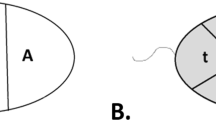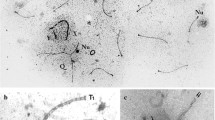Summary
Sex vesicle-nucleolus association was observed in 12% of zygotene and pachytene human spermatocytes using Giemsa and NOR-silver stained preparations. The silver-positive area of the nucleolus, corresponding to the nucleolus organizer (NOR), was usually close to the XY pair. C-banding frequently showed the terminal chromomere, formed by the condensed short arm of an acrocentric bivalent, attached to the sex vesicle. When a nucleolus produced by transcription of rDNA was connected to the short arm, it seemed to be secondarily associated with the sex vesicle. Non-transcribed ribosomal genes, which did not form a nucleolus, were revealed by in situ hybridization. Autoradiographs showed the rDNA-containing short arm of acrocentric bivalents associated with the sex vesicle in 18% of spermatocytes. The difference with the frequency of nucleolus-XY pair association was partially explained by the presence of inactive ribosomal genes. Moreover, electron microscopy showed that the dimensions of the newly formed nucleoli at early zygotene did not exceed 0.5 μm; they can be missed in light microscope investigations. From early zygotene to late pachytene, close relationships were observed between the sex vesicle chromatin and that of the associated acrocentric bivalent, especially in the short arm region. These relationships might explain the frequent involvement of acrocentrics in Y-autosome and X-autosome translocations occurring during male meiosis.
Similar content being viewed by others
References
Arroua NL, Hartung M, Devictor M, Bergé-Lefranc JL, Stahl A (1982) Localisation of ribosomal genes by in situ hybridization in the fibrillar centre of the nucleolus in the human spermatocyte. Biol Cell 44:337–340
Bobrow M, Pearson PL, Gollacott HEAC (1971) Para-nucleolar position of the human Y chromosome in interphase nuclei. Nature 232:556–557
Bostock CJ, Gosden JR, Mitchell AR (1978) Localisation of a male specific DNA fragment to a sub-region of the human Y chromosome. Nature 272:324–328
Brahic M, Stroop WG, Baringer JR (1981) Theiler's virus persists in glial cell during demyelinating disease. Cell 26:123
Carpenter ATC (1981) EM autoradiographic evidence that DNA synthesis occurs at recombination nodules during meiosis in Drosophila melanogaster females. Chromosoma 83:59–80
Cooke HJ, McKay RDG (1978) Evolution of a human Y chromosome specific repeated sequence. Cell 13:453–460
Cooper DN (1983) Eukaryotic DNA methylation. Hum Genet 64:315–333
Davis RM (1981) Localization of male determining factors in man: a thorough review of structural anomalies of the Y chromosome. J Med Genet 18:161–195
Driscoll DJ, Palmer CG, Melman A (1979) Nonhomologous associations of C-heterochromatin at human male meiotic prophase. Cytogenet Cell Genet 23:23–32
Eberle P (1966) Die Chromosomenstruktur des Menschen in Mitosis und Meiosis. Gustav Fischer Verlag, Stutgart
Ferguson-Smith MA (1964) The sites of nucleolus formation in human pachytene chromosomes. Cytogenetics 3:124–134
Ford EHR, Woollam DHM (1966) The fine structure of the sex vesicle and sex chromosome association in spermatocytes of mouse, golden hamster and field vole. J Anat 100:787–799
Gagné R, Laberge C, Tanguay R (1972) Interphase association of human “Y body” with nucleolus. John Hopkins Med J 130:254–258
Gall JG, Pardue ML (1971) Nucleic acid hybridization in cytological preparations. Methods Enzymol 21:470–480
Goldgefter LI, Gakjov NY, Ganin AF, Mosolov AN (1973) Identifying Y chromosome in interphase nuclei of the human brain. Experientia 29:1428–1429
Goodpasture C, Bloom SE (1975) Visualization of nucleolar organizer regions in mammalian chromosomes using silver staining. Chromosoma 53:37–50
Gosden JR, Mitchell AR, Buckland RA, Clayton RP, Evans HJ (1975) The location of four human satellite DNAs on human chromosomes. Exp Cell Res 92:148–158
Gosden JR, Gosden CM, Lawrie SS, Mitchell AR (1978) The fate of DNA satellite I, II and III and ribosomal DNA in a familial dicentric chromosome 13, 14. Hum Genet 41:131–141
Gosden JR, Gosden CM, Lawrie SS, Buckton KE (1979) Satellite DNA loss and nucleolar organizer activity in an individual with a de novo chromosome 13,14 translocation. Clin Genet 15:518–529
Gosden JR, Gosden CM, Rodeck CH (1984) Fetal sex determination using male-specific DNA analysis from chorionic villus biopsies in first trimester pregnancy. Human gene Mapping 7 Seventh International Workshop on human gene mapping. Cytogenet Cell Genet 37:483
Henderson AS, Eicher EM, Yu MT, Atwood KC (1976) Variation in ribosomal RNA gene number in mouse chromosomes. Cytogenet Cell Genet 17:307–316
Hernandez-Verdun D, Hubert J, Bourgeois CA, Bouteille M (1980) Ultrastructural localization of Ag-NOR stained proteins in the nucleolus during the cell cycle and in other nucleolar structures. Chromosoma 79:349–362
Hofgärtner FJ, Schmid M, Krone W, Zenzes MT, Engel W (1979) Pattern of activity of nucleolus organizers during spermatogenesis in Mammals as analyzed by silver staining. Chromosoma 71:197–216
Holm PB, Rasmussen SW (1977) Human meiosis. I. The human pachytene caryotype analyzed by three dimensional reconstruction of the synaptonemal complex. Carlsberg Res Commun 42:283–323
Iorio RJ, Wyandt HE (1973) Quinacrine studies of sex chromatin and nucleoli in human brain. Humangenetik 20:329–333
Johannisson R, Gropp A, Winking H, Coerdt W, Rehder H, Schwinger E (1983) Down's syndrome in the male. Reproductive pathology and meiotic studies. Hum Genet 63:132–138
Kierszenbaum AL, Tres LL (1974) Nucleolar and perichromosomal RNA synthesis during meiotic prophase in the mouse testis. J Cell Biol 60:39–53
Knibiehler B, Mirre C, Hartung M, Jean P, Stahl A (1981) Sex vesicle-associated nucleolar organizers in mouse spermatocytes: localization, structure and function. Cytogenet Cell Genet 31:47–57
Kurnit DM (1979) Satellite DNA and heterochromatin variants: the case for unequal mitotic crossing-over. Hum Genet 47:169–186
Luciani JM (1970) Les chromosomes méiotiques de l'Homme. II. Le nucléole, les chiasmas. Ann Genet (Paris) 13:169–182
Luciani JM, Devictor-Vuillet M, Gagné R, Stahl A (1974) An air-drying method for first meiotic prophase preparations from mammalian ovaries. J Reprod Fertil 36:409–411
Luciani JM, Morazzani MR, Stahl A (1975) Identification of pachytene bivalents in human male meiosis using G-banding technique. Chromosoma 52:275–282
Mattéi MG, Mattéi JF, Ayme S, Giraud F (1982) X-autosome translocations. Cytogenetic characteristics and their consequences. Hum Genet 61:295–309
Miller OJ, Schnedl W, Allen J, Erlanger BF (1974) 5-Methylcytosine localized in mammalian constitutive heterochromatin. Nature 251:636–637
Miller OJ, Drayna D, Goodfellow P (1984) Report of the committee on the genetic constitution of the X and Y chromosomes. Human gene mapping 7. Seventh International Workshop on Human Gene Mapping. Cytogenet Cell Genet 37:176–204
Moses MJ, Counce SJ, Paulson DF (1975) Synaptonemal complex complement of man in spreads of spermatocytes, with details of the sex chromosomes pair. Science 187:363–365
Noël L (1979) Translocation de l'hétérochromatine distale du chromosome Y sur un autosome. 4 observations familiales. Thèse de Médecine, Grenoble
Ohno S, Kaplan WD, Kinosita R (1957) Heterochromatic regions and nucleolus organizers in chromosomes of the mouse, Mus musculus. Exp Cell Res 13:358–364
Rappold GA, Cremer T, Cremer C, Back W, Bogenberger J, Cooke HJ (1984) Chromosome assignment of two cloned DNA probes hybridizing predominantly to human sex chromosomes. Hum Genet 65:257–261
Rasmussen SW, Holm PB (1978) Human meiosis II. Chromosome pairing and recombination nodules in human spermatocytes. Carlsberg Res Commun 43:275–327
Sachs L (1954) Sex linkage and the sex chromosomes in man. Ann Eugen 18:255–261
Schmid M, Wogel W, Krone W (1975) Attraction between centric heterochromatin of human chromosomes. Cytogenet Cell Genet 15:66–80
Schmid M, Grunert D, Haaf T, Engel W (1983) A direct demonstration of somatically paired heterochromatin of human chromosomes. Cytogenet Cell Genet 36:554–561
Schnedl W, Dev VG, Tantravahi R, Miller DA, Erlanger BF, Miller OJ (1975) 5-Methylcytosine in heterochromatic regions of chromosomes: chimpanzee and gorilla compared to the human. Chromosoma 59:59–66
Seuanez H, Mitchell AR, Gosden JR (1976) The chromosomal distribution of human satellite III DNA during meiosis. Cytobios 15:79–84
Smith A, Fraser IS, Elliott G (1979) An infertile male with balanced Y;19 translocation. Review of Y; autosome translocations. Ann Genet (Paris) 22:189–194
Solari AJ (1974) The behavior of the XY pair in mammals. Int Rev Cytol 38:273–317
Solari AJ (1980) Synaptonemal complexes and associated structures in microspread human spermatocytes. Chromosoma 81:315–337
Solari AJ, Tres LL (1967) The localization of nucleic acids and the argentaffin substance in the sex vesicle of mouse spermatocytes. Exp Cell Res 47:86–96
Solari AJ, Tres LL (1970a) The three-dimensional reconstruction of the XY chromosomal pair in human spermatocytes. J Cell Biol 45:43–53
Solari AJ, Tres LL (1970b) Ultrastructure and histochemistry of the nucleus during male meiotic prophase. In: Rosenberg E, Paulsen A (eds) The human testis. Plenum Press, New York, pp 127–138
Stahl A, Luciani JM, Hartung M, Devictor M, Bergé-Lefranc JL, Guichaoua M (1983) Structural basis for Robertsonian translocations in man: association of ribosomal genes in the nucleolar fibrillar center in meiotic spermatocytes and oocytes. Proc Natl Acad Sci USA 80:5946–5950
Therkelsen AJ, Petersen GB (1971) Frequency of “Y” chromatin body in human skin fibroblasts in tissue culture and its relation to growth phase. Exp Cell Res 65:473–475
Tres LL (1975) Nucleolar RNA synthesis of meiotic prophase spermatocytes in the human testis. Chromosoma 53:141–151
Woollam DHM, Ford EHR (1964) The fine structure of the mammalian chromosome in meiotic prophase with special reference to the synaptinemal complex. J Anat 98:163–173
Author information
Authors and Affiliations
Rights and permissions
About this article
Cite this article
Stahl, A., Hartung, M., Devictor, M. et al. The association of the nucleolus and the short arm of acrocentric chromosomes with the XY pair in human spermatocytes: Its possible role in facilitating sex-chromosome acrocentric translocations. Hum Genet 68, 173–180 (1984). https://doi.org/10.1007/BF00279310
Received:
Revised:
Issue Date:
DOI: https://doi.org/10.1007/BF00279310




